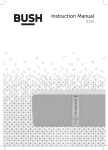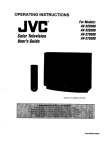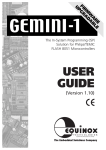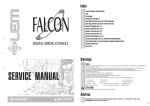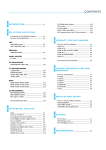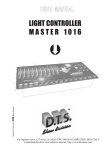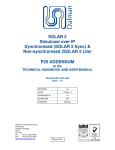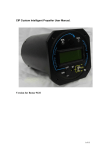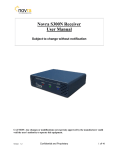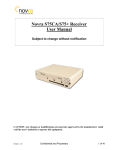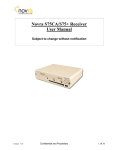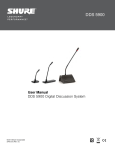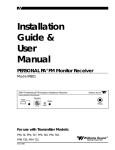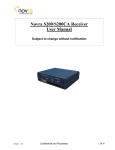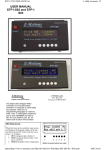Download CDpro User manual
Transcript
Premium 10501 05-07-00 P10501A06.DOC User Manual Premium 10501 PHILIPS OPTICAL STORAGE USER MANUAL PREMIUM 10501 Philips Components Premium 10501 05-07-00 P10501A06.DOC draft User Manual Premium 10501 Preface This document gives some application information how to use the Premium 10501 The Starter kit Premium 10501 is intended to be used for high-end video/audio and Jukebox applications. Using the kit and documentation should make it possible to provide a quickly start of the design-in work. The Premium 10501 is a complete functional module that consists of the CD engine, cables and documentation. The CD engine is equipped with a PCB underneath the mechanism. The PCB contains the electronics, and provides the necessary interface to connect the unit to the external application circuit. The unit can be controlled through the so-called DSA bus. Available DSA commands are described in the Premium 10501 documentation. A floppy with DSA control software, which runs on an IBM compatible PC, is available and is part of the documentation. The Premium 10501 is not indented to be copied. ©Philips Electronics N.V. 2000 All rights reserved. Reproduction in whole or in part is prohibited without the written consent of the copyright owner. The information presented in this document does not form part of any quotation or contract, is believed to be accurate and reliable and may be changed without notice. No liability will be accepted by the publisher for any consequence of its use. Publication thereof does not convey nor imply any license under patent- or other industrial or intellectual property rights. Philips components © 2000 Philips Electronics N.V. All rights reserved Page 2 Premium 10501 P10501A06.DOC 05-07-00 draft User Manual Premium 10501 PHILIPS LASER OPTICS USER MANUAL PREMIUM 10501 Author(s) Phil Wu Arthur He Philips Components Optical Storage Shanghai Keywords: High-end Audio Jukebox DSA CD10 VAU1254 Premium 10501 Note: The publisher reserve the right to change the data mentioned in this document without prior notice. Philips components © 2000 Philips Electronics N.V. All rights reserved Page 3 Premium 10501 05-07-00 P10501A06.DOC draft User Manual Premium 10501 Revision history Version Date Version 0.1 draft version 05-07-00 Philips components Remarks © 2000 Philips Electronics N.V. All rights reserved Page 4 Premium 10501 P10501A06.DOC 05-07-00 draft User Manual Premium 10501 Table of Contents 1. Introduction........................................................................................................................................................... 6 1.1 Abbreviations used ........................................................................................................................................ 6 2. System overview................................................................................................................................................... 6 2.1 Features............................................................................................................................................................ 7 2.2 Some numbers ................................................................................................................................................ 7 3. PCB key component and connector placement............................................................................................... 8 4. Configuration options.......................................................................................................................................... 8 5. PCB connector interface description................................................................................................................. 9 5.1 The actuator connector (internal connection)........................................................................................... 9 5.2 The diode flex connector (internal connection)........................................................................................ 9 5.3 The DSA connector..................................................................................................................................... 10 5.4 The I2S/graphics connector....................................................................................................................... 10 5.5 The EBU connector..................................................................................................................................... 11 5.6 The power connector................................................................................................................................... 11 5.7 The line-out connector................................................................................................................................ 12 5.8 The 16 MHz clock output .......................................................................................................................... 12 6. The DSA control interface ................................................................................................................................ 12 6.1 DSA interface bus protocol........................................................................................................................ 13 6.2 DSA Commands .......................................................................................................................................... 13 6.3 Summary of DSA Control commands ..................................................................................................... 14 7. Micro Controller pinning .................................................................................................................................. 15 7.1 General........................................................................................................................................................... 15 7.2 Features.......................................................................................................................................................... 15 7.3 Micro controller Pinning............................................................................................................................. 15 8. Power requirements ........................................................................................................................................... 17 8.1 Switching the power on /off....................................................................................................................... 17 8.2 Rise time of the power supplies ................................................................................................................ 17 8.3 Ventilation..................................................................................................................................................... 17 9. Getting the best audio performance................................................................................................................. 18 9.1 Absolute audio phase.................................................................................................................................. 18 10. Connecting the Premium 10501..................................................................................................................... 19 11. Problem solving................................................................................................................................................ 20 12. General application information.................................................................................................................... 20 Philips components © 2000 Philips Electronics N.V. All rights reserved Page 5 Premium 10501 05-07-00 P10501A06.DOC draft User Manual Premium 10501 1. Introduction Using the Premium 10501 module, the user will get a high performance CD-engine, which is designed to deliver an extremely good playability and very low mechanical playing noise. The module provides standard to high end audio quality output signals. For those customers who strive for extreme high performance audio, fine tuning the audio output with additional post filtering can be used. Using a special external DAC is still possible as the I2S signals are available. Refer for all technical specifications to the data sheets only 1.1 Abbreviations used BCCDAC Bitstream Continuous Calibration Digital to Analog Converter CD Compact Disc CD-DA Compact Disc Digital Audio CD10 SAA7324 Compact Disc Decoder & Digital Servo DAC Digital to Analog Converter DSA Data Strobe Acknowledge EBU European Broadcast Union HF High frequency (EFM) signal LDGU Laser Detector Grating Unit OTP One-time Programmable (Eprom controller). QFP Quad Flat Pack VAM Video Audio Module (CD Mechanism) VAU Video Audio Unit (Assembly of VAM and PCB) 2. System overview Mechanism PCB HF signal Diode Amplifier Laser Supply LF signals TZA1022 HF Equalizer Discrete circuit Stereo DAC Digital Servo Control and CD-Decoder TDA1305T Left audio Right audio I2S IEC958 SAA7324 M2 16MHz optional Laser on/off FocRa SleMo us dialdgetor Control Micro Controller VAM1254 3-beam Mechanism DSA control 2x Dual Servo Drivers Flash interface TDA7073 Supply Figure 1: Block diagram The left part of this diagram shows the VAM1254 mechanism. The total assembly of VAM1254 and the PCB is called the CD Engine. The Premium 10501 starterkit consist of the CD engine, some cables, DSA interface, control software on floppy and documentation. Philips components © 2000 Philips Electronics N.V. All rights reserved Page 6 Premium 10501 P10501A06.DOC 05-07-00 draft User Manual Premium 10501 2.1 Features • • • • • • • • The 8-bit pre-programmed micro controller provides the following functions (summary): Execute DSA commands towards the VAM1254 mechanism and CD10 decoder. Return subcode and status information to external controller via DSA bus. Send sledge home at power up. Flash new software into micro controller The mechanism VAM1254 is three-beam mechanism with single focault focus error detection and LDGU (Laser Detector Grating Unit) holographic pick-up. Special S(ilent) version of digital servo controller with zero potmeters to fine-tune the application. On board high performance Bitstream Continuous Calibration DAC with analogue stereo lineoutput. Digital EBU output. I2S output for connection to external DAC's or MPEG decoder Optional 16 MHz clock output Double (+5 and +9 V) power supply for normal operation and +12 V is needed during flash. 2.2 Some numbers Software version: Software ROM size: Laser power : HF signal amplitude: Focus bandwidth: Radial bandwidth: Audio output level: Audio output impedance: Philips components Version 4.x About 32k bytes. 375 ìW. I11 about 1.0 V pp (measured at HFIN) 1000 Hz. 1200 Hz. 1.5Veff 110 ohm © 2000 Philips Electronics N.V. All rights reserved Page 7 Premium 10501 05-07-00 P10501A06.DOC draft User Manual Premium 10501 3. PCB key component and connector placement DSA 1 1 Driver Audio CD decoder + servo DAC 1 Flash interface 1 16 Mhz (optional) Micro P Driver 1 1 Power IEC958 1 I2S/CDG Figure 2: PCB component view 4. Configuration option The PCB is prepared for the following option: Option 16MHz output Philips components Function Connector X1007 not stuffed (default) Connector can be stuffed if 16 MHz is needed e.g. in case of Video applications © 2000 Philips Electronics N.V. All rights reserved Page 8 Premium 10501 05-07-00 P10501A06.DOC draft User Manual Premium 10501 5. PCB connector interface description 5.1 The actuator connector (internal connection) The 6 pole Actuator connector is a Molex type 52207-0690 series connector. PIN Function I/O 1 S1+ O 2 S1O 3 Home switch I 4 GND 5 MO 6 M+ O Table 1: Actuator connector pinning Description Control signal for sledge motor Control signal for sledge motor Home switch input Ground for home switch Control signal for disc motor Control signal for disc motor The signals SL+ and SL- form the connections to the sledge motor. The signals M+ and M- form the connections to the turntable motor. The home switch gives the microprocessor information whether the sledge is moved completely to the inner side. The "GND" supplies the other end of the home switch, but as well functions as grounding wire for the ornamental plate. 5.2 The diode flex connector (internal connection) The 16 pole flex connector is a Molex type 52207-1690 connector. PIN Function 1 Vsub 2 GND 3 VDD 4 RF 5 LDON 6 R2 7 R1 8 B3 9 B2 10 B1 11 FTC 12 RW 13 FOC+ 14 FOC15 RAD+ 16 RADTable 2: Flex connector pinning Philips components I/O P P P O I I I I I I O O O O O Description +5V substrate for detector diodes LDGU ground Supply voltage for pre-amplifier Not equalised HF signal Laser on/off control H=laser on, L=laser off Signal from detector diode (satellite diode) Signal from detector diode (satellite diode) Signal from detector diode (central hf diode) Signal from detector diode (central hf/focus diode) Signal from detector diode (central hf/focus diode) NOT USED Control of CD-DA and CD-RW Control signal for focus actuator Control signal for focus actuator Control signal for radial actuator Control signal for radial actuator © 2000 Philips Electronics N.V. All rights reserved Page 9 Premium 10501 05-07-00 P10501A06.DOC draft User Manual Premium 10501 5.3 The DSA connector The 6 pole DSA connector is a JST PH series connector. PIN Function 1 ACK 2 DDA 3 DST 4 DRST 5 GND 6 LASER-OFF! Table 3: DSA connector pinning I/O I/O I/O I/O I O I Description Acknowledge Data Strobe Reset Ground Control input for laser H=laser on, L=laser off When controlling the Premium 10501 with an external PC, the reset line is unused. Note that when the reset line is pulled high, this will reset the servo processor. CAUTION: Do not connect the external reset line to ground directly. This will prevent the microprocessor from being reset properly at power-up! The 6th pin is added for safety requirements. The user can connect this pin to a "doorswitch" such that whenever a user opens the lid of the cabinet, this will switch off the laser power. A "low" on this pin will switch off the laser power. When not connecting this pin, it will float high. It is recommended when using long external wiring to the laser_off pin to put a small 100 nF capacitor over the laser_off input to prevent noisy glitches to switch off the jukebox module. The mating (female) connector is an assembly of a JST type PHR-6 housing with 6 contacts type SPH002T-P0.5S. Recommended wire is type AWG24. 5.4 The I2S/graphics connector The I2S/Graphics connector is a JST PH series connector. This is a 6 pole connector. PIN Function 1 MISC 2 SCLK 3 WCLK 4 DATA 5 GND 6 V4 (serial CDG output) Table 4: Connector pinning I/O O O O O O O Description C2 error flag Serial clock Word clock (word select) Data Ground Serial CD Graphics output When using the engine as a standard CD-DA module, without the MPEG option, an external DAC PCB may be connected to this connector. This external DAC will only use the WCLK, SCLK, DATA and ground lines of this connector. Note that for this application, the module has to be programmed for audio mode via the DSA interface. Data will come out via the I2S connector in the I2S (default) or EIAJ (programmable via DSA command) format. Figure 3: I2S output timing. Remark: The I2S output timing depends on the settings by software, see DSA commands. The MISC/error pin is a multi-purpose pin. When the module is in "audio mode", this pin will supply a clock at double the speed of the WCLK clock. In CD-ROM mode however, this "MISC/error" pin will Philips components © 2000 Philips Electronics N.V. All rights reserved Page 10 Premium 10501 05-07-00 P10501A06.DOC draft User Manual Premium 10501 signal uncorrectables to the MPEG board. A logic "1" means that data output by the data interface is incorrect. A logic "0" means data is OK. Also an external CD-graphics decoder may be connected to this interface for karaoke applications. The external CD-G decoder uses both the I2S signals as well as the V4 connector pin. The V4 pin provides the QRSTUVW (Q-W channel) subcode flags in a serial way. The R-W flags can be used by the CD-G decoder. A group of 96*6 bits forms one CD-G block. The MISC pin is, or can be, used when the output of the Premium 10501 should be connected to a CDROM decoder or MPEG decoder. For audio applications this pin is not used. The mating (female) connector is an assembly of a JST type PHR-6 housing with 6 contacts type SPH002T-P0.5S. Recommended wire is type AWG24. 5.5 The EBU connector The EBU connector is a JST PH series connector. This is a 2 pole connector. PIN Function 1 Dig-GND 2 EBU dig data (IEC958) Table 5: EBU connector pinning I/O O O Description Ground EBU output according IEC958 standard Equipment using an EBU interface, or measurement equipment may be connected to this interface. This interface uses an unbalanced line (two-wire transmission) as described in the IEC standard. The interconnecting cable should be screened and have a characteristic impedance of 75 at 2.8224 MHz. The signal amplitude should be 0.5V +/-20% peak-to-peak, when measured across a 75 ohm resistor connected to the output terminal, without any interconnecting cable present. Rise and fall times are in the order of 10 ns (under the same conditions). The mating (female) connector is an assembly of a JST type PHR-2 housing with 2 contacts type SPH002T-P0.5S. 5.6 The power connector The 4 pole power connector is a JST PH series connector. PIN Function 1 GND 2 +9 V supply 3 GND 4 + 5 V supply Table 6: Power connector pinning I/O I I I I Description Ground pin 9V (not connected on PCB to ground pin 5V)! 9 volt supply for motor and actuator drivers TDA7073 Ground pin 5V (not connected on PCB to ground pin 9V)! 5 volt supply Pin 1 and 2 function as a supply for the actuator drivers (+9V). Pin 3 and 4 supply the rest of the circuitry (+5V). The GND connection must be connected together at the supply side to prevent unwanted disturbance signals. The mating (female) connector is an assembly of a JST type PHR-4 housing with 4 contacts type SPH002T-P0.5S. Recommended wire is type AWG24. Philips components © 2000 Philips Electronics N.V. All rights reserved Page 11 Premium 10501 05-07-00 P10501A06.DOC draft User Manual Premium 10501 5.7 The line-out connector The 4 pole line-out connector is a JST PH series connector. PIN Function I/O 1 Right audio O 2 A-GND O 3 A-GND O 4 Left audio O Table 7: Line-out connector pinning Description Audio output right channel Ground Ground Audio output left channel The mating (female) connector is an assembly of a JST type PHR-4 housing with 4 contacts type SPH002T-P0.5S. Recommended wire is type AWG24. 5.8 The 16 MHz clock output The 3 pole clock output connector is a JST PH series connector. This connector is optional and not stuffed on the PCB. PIN Function I/O 1 Dig-GND O 2 CLK16 O 3 Dig-GND O Table 8: Clock-out connector pinning Description Ground 16.9344 MHz clock output Ground This clock output provides a 16.9344 Mhz clock which can be used by MPEG boards which require a clock synchronous with the CD decoder. 5.9 Flash interface The 5 pole flash interface connector is a JST PH series connector. PIN Function I/O 1 +12 V I 2 PSEN I 3 RXD I 4 TXD O 5 GND I Table 8: Flash interface connector pinning Description Power supply for programming Program store enable Receiver line in serial port Transmitter line in serial port Ground The mating (female) connector is an assembly of a JST type PHR-5 housing with 5 contacts type SPH002T-P0.5S. Recommended wire is type AWG24. 6. The DSA control interface The DSA (Data Strobe Acknowledge) interface is a serial interface used for communication between 2 processors. One processor is located on the CD engine PCB, the other one might be an external processor on another PCB or a PC computer. In this paper we call the external processor the "host". Communication between host and CD engine uses a 16 bit structure. The 16 bits contain a COMMAND byte followed by a DATA byte, transmitted in one string. Transmission is done with the MSB first. Both processors can send commands to the other. The CD-engine for example can send time information to the host. Philips components © 2000 Philips Electronics N.V. All rights reserved Page 12 Premium 10501 05-07-00 P10501A06.DOC draft User Manual Premium 10501 6.1 DSA interface bus protocol Each data communication consists of three phases: • Synchronisation phase. • Data transmission. • Acknowledge phase. A full description of the protocol is documented in a separate manual in the premium 10501 starterkit documentation. 6.2 DSA Commands The commands understood by the servo processor on the CD engine are documented in a separate manual in the Premium 10501 DSA documentation. The table in next chapter gives an indication of the commands to be expected. The servo processor on the CD engine does not only receive commands, it will give back information as well. The information to be output by the servo processor can be programmed by putting the servo processor in a different mode. For instance, there is a mode, such that the servo processor gives no information back at all, or another mode, where the processor gives back subcode information, and so on. Attached at the end of this document, some examples are given. Philips components © 2000 Philips Electronics N.V. All rights reserved Page 13 Premium 10501 05-07-00 P10501A06.DOC draft User Manual Premium 10501 6.3 Summary of DSA Control commands The commands are divided into the following groups: • Control commands • Info retrieve commands • Mode setting commands • Service commands A full description of the commands is given the Premium 10501 starterkit documentation. Command name Play title Stop Read TOC Read long TOC Clear TOC Pause Pause release Goto time Spin up Play A till B time Function Play title number nn and respond with specified info according Set Mode Stop playing, sledge move to the home position, disc is stopped Reads the TOC of the specified session and sends info to the user processor Reads the complete TOC and sends info to user processor Clear the TOC stored in RAM Stop playing the disc, present sledge position is maintained Continue playing the disc at present sledge position Jump to the absolute requested time location on disc and respond with found Spin up the disc at the specified session and respond with found Play from absolute requested time A till absolute time B Summary Info retrieve commands Command name Function Get tittle length Send the time of the specified title to the user processor Get complete time Send the absolute disc time to the user processor Get last error Send the last encountered error to the user processor Get disc status Send the current disc status Get session info Send the number of finalised sessions on the disc Summary of Mode setting commands Command name Function Set Mode Mode setting for speed, TOC info, and activates the AUDIO or ROM mode Clear error Clear the latest error code Release A->B time Releases the A till B time feature Set volume Set the volume level (only in audio mode) from 0 till 255 (full scale) Set DAC mode Set I2S output format and error correction for AUDIO Summary of Service commands Command name Function Service mode on Switches the service mode on and gives the servo version number Service mode off Switches the service mode off and gives the servo version number Sledge jump Make a sledge jump of 300 ms Sledge off Switches the sledge movement off and go to the inner position Focus on Switches the focus on Focus off Switches the focus off Turntable motor on Switches the turntable motor on Turntable motor off Switches the turntable motor off Radial on Switches the radial control loop on Radial off Switches the radial control loop off Laser on Switches the laser on Laser off Switched the laser off Philips components © 2000 Philips Electronics N.V. All rights reserved Page 14 Premium 10501 05-07-00 P10501A06.DOC draft User Manual Premium 10501 7. Micro Controller pinning Remark: Micro controller pinning given in this chapter, is for information only and can be used in case of debugging. No guarantee can be given that NC (Non Connected) pins will not be assigned in future software versions. 7.1 General The micro controller is specially designed for the high-end CD engine, to control the mechanism and CD10, and is based on the generic P89C51xx+ CMOS single-chip micro controller with internal 64K*8 ROM. Device name: Function: Package: P89C51RC+/ P89C51RD+ High-end Audio and Video CD applications with VAM1254 and CD10 44 pin QFP 7.2 Features • • • • • Controls the CD10 decoder/servo IC Translate the high level DSA commands to low level CD-player commands Provides subcode/time information and player status information Use the DSA bus protocol as communication to an external processor Flash new software into micro controller 7.3 Micro controller Pinning Pin 1 2 3 4 5 6 7 8 9 10 11 12 13 14 15 16 17 18 19 20 21 22 23 24 25 27 Micro controller (P89C51RC+/P89C51RD+) Package: QFP44 Name I/O Function P1.5 DSA-DATA I/O DSA data P1.6 DSA-STR I/O DSA strobe P1.7 NC RST DSA-RST I HIGH: Microcontroller is in reset mode P3.0/RxD RXD I Serial port receiver NC1 P3.1 /TxD TXD O Serial port transmitter P3.2/INT0! Laser on O Laser power on-off control HIGH = laser on, LOW = laser off P3.3/INT1! NC P3.4 NC P3.5 NC P3.6 NC P3.7 NC XTAL2 O Crystal Oscillator. XTAL1 I Crystal Oscillator (12 MHz) GND Ground NC2 P2.0 DMSB O Audio enable of double speed input for DAC P2.1 NC P2.2 NC P2.3 RW NC Control of CD-DA and CD-RW P2.4 HOMESW! I LOW: Sledge of VAM1254 mechanism is in home position P2.5 NC P2.6 NC P2.7 F250 I Factory design ALE/PROG! NC Address Latch Enable. Philips components © 2000 Philips Electronics N.V. All rights reserved Page 15 Premium 10501 05-07-00 P10501A06.DOC draft User Manual Premium 10501 This micro controller does not use any external RAM or ROM. This pin should be left unconnected. 28 29 30 31 32 33 34 35 36 37 38 39 40 41 42 43 44 NC3 I EA!/ Vpp P0.7/AD7 P0.6/AD6 P0.5/AD5 P0.4/AD4 P0.3/AD3 P0.2/AD2 P0.1/AD1 P0.0/AD0 VCC S2 S1 P1.0 P1.1 P1.2 P1.3 P1.4 DSA-ACK Philips components Reset Mute On_track HFDET SDA SILD SCL O O NC O O O NC I NC4 I/O NC I/O O O Not External Address. This pin should be held high to ensure that the microcontroller uses internal program memory only. +12V during flash. Switching control for equaliser & filter Switching control for equaliser & filter Reset for CD10 SAA7324 Mute signal for DAC Factory design HF detector +5V supply DSA acknowledgement Serial data for communication with CD10 R/W control and data strobe to CD10 Serial bit clock for communication to CD10 © 2000 Philips Electronics N.V. All rights reserved Page 16 Premium 10501 05-07-00 P10501A06.DOC draft User Manual Premium 10501 8. Power requirements The CD Engine PCB requires 2 external power supplies. This section shows the required supply levels and currents. Stop mode +5V 120 mA +9V 40 mA Table 10: Power requirements Spin up/down & jump 180 mA 600 mA Normal play 190 mA 120 mA The peak current of 600 mA for the +9V supply will be during spin up or down of the disc. This will take about 1-2 seconds, then the power consumption will drop to the average normal play value. 8.1 Switching the power on /off Between switching off the power of the module and switching it back on again, the user should wait 1 sec. (Just like in any other audio application). This to make sure that the microprocessor is properly reset during power up. The max. RESET TIME is 1 sec. after the 5 V has been switched on. After this time, commands (e.g. SPIN_UP) may be sent. If the sledge is - on this moment - not yet at the inner position, the command will be executed on the moment the sledge is home! If the user wants to avoid improper reset of the microprocessor on successive power on/power-off cycling without waits, an external reset pulse can be given to the microprocessor via the DSA interface, to guarantee that the microprocessor is reset. 8.2 Rise time of the power supplies If the +9V power comes up faster than the +5V, the user may notice spurious movements of the actuator upon power up. This is because in this situation, the drivers are powered up first by the +9V supply, then after the drivers are powered up, the +5V is still rising. Now the driver will follow the power up pattern of the +5V and put this waveform in an amplified way on the actuators. This will cause movement of the actuators. If the +5V and +9V have the same rise time, the actuator movement is reasonable. If the user does not allow any movement at all, the +5V supply should come up a little faster ( 150 msec) than the +9V supply, at start-up. 150 msec is enough here, increasing this figure is not necessary for normal supplies. Only when the rise time of the +5V is very slow, the 150 msec have to be increased. The same for switching of the power supply, only now it's the other way round: When switching off the power supply, the +9V should be switched off first. When switching the power on or off a "very low level" click may be heard through the audio output. When using amplifiers with proper speaker protection during power up/down, this will cause no trouble. 8.3 Ventilation The +9 V terminal can be connected to a power supply level between 8.1 and 10.35V. It is possible to operate it with higher supply levels, but this extra power will only be translated into extra heat which in turn will decrease the lifetime of the product, so it is recommended to operate it at supply levels between 8.1 and 10.35V. When operating the CD engine inside a closed cabinet on supply levels higher then 10.35V, the temperature of the module will substantially rise, thus warming up the laser. This will reduce the lifetime of the module. Therefore, when using higher supply levels, it is recommended to provide some ventilation holes (or a fan) inside the cabinet in the neighbourhood of the two TDA7073AT drivers. These two IC's can get very hot during operation, especially during spin up or down and accessing a new song on the disc. Philips components © 2000 Philips Electronics N.V. All rights reserved Page 17 Premium 10501 P10501A06.DOC 05-07-00 draft User Manual Premium 10501 9. Getting the best audio performance The usual audio software on CD-DA discs has a SNR of 98dB max. The output of CD10 is already deemphasised, and then again quantized to 16 bits again. This means at this stage, the theoretical max. attainable SNR which can be get from the BCCDAC2 will be 98dB. Measured operational values are about 97dB. THD at 0dB input signal will be -85dB, at -60dB input signal will be -35 dB. For the best audio performance, the power supply wires should be type AWG24 wire. The PCB should be connected to 2 independent power supplies. One for the +5V, the other for the +9V. The ground terminals of the two power supplies must be connected at the supply side to reduce voltage drop or ripple over the power wiring. The ground terminals of the supply connector are not connected on the PCB!!! 9.1 Absolute audio phase One of the properties of the BCCDAC2 is that the phase of the audio output has turned 180 degree. For those customers who want to feature absolute phase in their design, an inverting amplifier should be used between premium module and speaker/headphone output. Philips components © 2000 Philips Electronics N.V. All rights reserved Page 18 Premium 10501 05-07-00 P10501A06.DOC draft User Manual Premium 10501 10. Connecting the Premium 10501 DSA interface To PC Audio out DSA 1 Audio To PC 1 RS 232 FLASH Interface Pcb Driver CD decoder + servo DAC 1 Flash interface 1 16 Mhz (optional) MicroP Driver 1 1 1 Power IEC958 +5 /+ 12V External Power Supply I2S/CDG _ + 9 V Power Supply + _ + 5 V Power Supply + Figure 4: Connecting the Premium 10501. Remark: The grounds (-) of the +5V and +9V must be interconnected at the power supply side. These grounds are not interconnected at the PCB side!! Philips components © 2000 Philips Electronics N.V. All rights reserved Page 19 Premium 10501 05-07-00 P10501A06.DOC draft User Manual Premium 10501 11. Problem solving. Some tips on servicing the Premium 10501, when the set does not work correctly. • At start-up the sledge does not move home, but the actuator starts ramping. Probably the servo microprocessor is not running. Check microprocessor oscillator. • At start-up, the sledge moves wildly in both directions. Homeswitch short circuit to ground. • Set gets into focus, but does not start spindle motor. Check pin 26 of CD10. If there's a clock there, there must be something wrong in the spindle motor driver stage. If there is no clock at pin 26 of CD10, check the oscillator christal circuit of CD10. • At start-up the sledge moves home and then starts rattling. The homeswitch wiring probably interrupted or dirty contacts of homeswitch. • At start-up the sledge moves home, then the set does not do anything at all. Probably something wrong with the DSA wiring. • CDM does not ramp to catch focus. Software gives message "FOCUS ERROR/ NO DISC". Check voltage across the safety resistor 3208 12. General application information The application covers the high end-audio, Video and Jukebox applications • Speed n =1 • Speed n = 2 (optional), design is functional prepared but not released. Position of operation: • Horizontal is recommended • Vertical is allowed with preferred side A or B down, see VAM1254 data sheet Safety: • Special measures have been taken for safety reasons: 1. A laser off input is implemented 2. Safety resistors (NFR) have been applied The Set maker is responsible for safety of the total application including the CD engine used in this application • Radiation: Not valid, to be specified by the set maker Although the setmaker is responsible, measures have been taken to reduce radiation by using double sided PCB and SMD technology. Shielding: If a metal shielding is used with a distance of less then 5 mm to the PCB, the shielding has to be connected to the PCB ground. Philips components © 2000 Philips Electronics N.V. All rights reserved Page 20




















